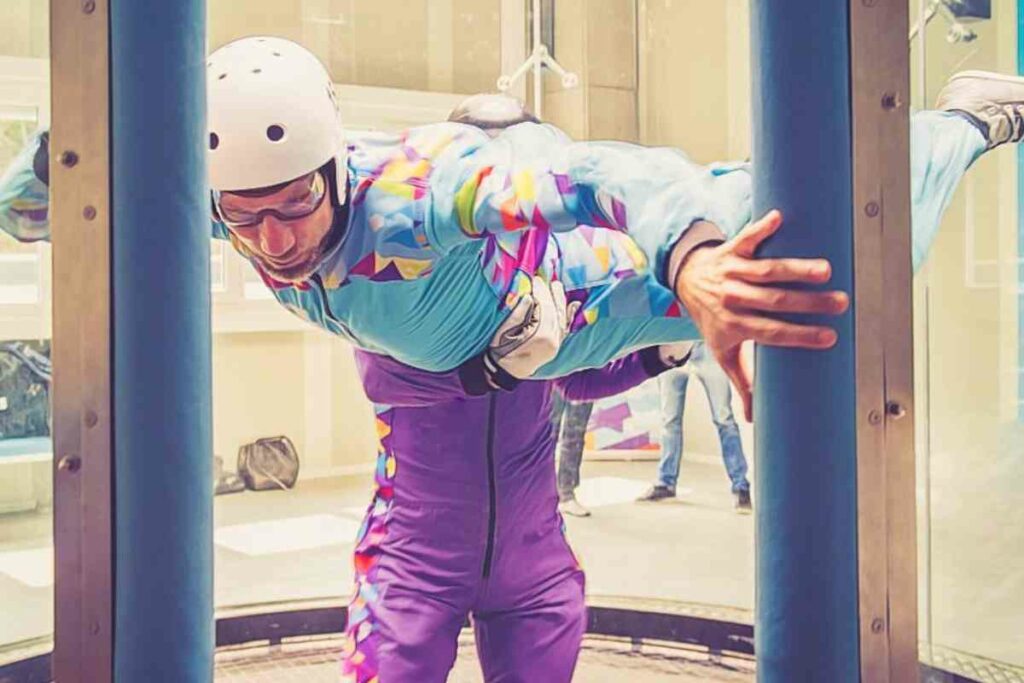Indoor skydiving is a unique, safer take on a truly thrilling activity.
This being said, there are still some smaller risks involved, which may prompt you to ask, is indoor skydiving allowed in all countries?
While there are some exceptions, indoor skydiving is indeed allowed in most countries. In the Netherlands, China, Denmark, Canada, Ukraine, and New Zealand… there are indoor skydiving opportunities near and far!
Risks Associated
There are some risks associated with indoor skydiving, which may cause you to wonder if it’s allowed everywhere or not.
While indoor skydiving is in fact allowed just about everywhere, the risks are still important to be aware of:
- The primary risk when it comes to indoor skydiving is bumps. These are typically from knocking into a fellow indoor skydiver, but can also come from bumping into the wind tunnel wall. Fortunately, indoor skydiving places provide elbow and knee pads, and a helmet, to help prevent bumps and injury. Maintaining your form will also make avoiding collisions easier!
Read before you go – Can You Indoor Skydive If You Have a Medical Condition?
- Bruises are fairly uncommon when indoor skydiving, but not unheard of. These can happen if you lose control and bump someone or the walls of the tunnel too hard. Luckily, your instructors won’t let you forget your elbow and knee pads or helmet, so you’ll be covered!
- If you’ve ever had a dislocation, you may want to reconsider indoor skydiving. This is not to say it’s impossible, but it does make additional dislocation a risk. You’ll have a lot of wind pressure going against you, and you depend on moving your body in order to maneuver. You may be able to successfully indoor skydive still with the proper brace. Just keep this in mind!
Is Indoor Skydiving Allowed In All Countries?
While there are some stricter restrictions on outdoor skydiving, indoor skydiving is allowed just about everywhere (with possibly a few exceptions).
You can do an online search for ‘indoor skydiving near me’ and find skydiving places worldwide.
This means that, no matter where you live, you can probably find somewhere to indoor skydive – what luck!
Maximize your indoor skydiving experience with the help of this comprehensive beginner’s guide, offering a wealth of information and practical tips.
Requirements for an Indoor Skydiver
Of course, there are a few requirements in order to skydive.
Otherwise, you won’t be allowed:
- First off, indoor skydivers must be at least 3-4 years old. They should be able to stand and hold up their heads, and understand basic commands so that they can communicate with the instructor!
- Second, indoor skydivers must not be pregnant. Indoor skydiving while pregnant can cause complications, like placenta abruption (this is when the placenta prematurely detaches from the uterine wall). Uterine prolapse is also a risk!
- Indoor skydivers must not exceed 250 pounds (this may vary slightly depending on the place).
- Finally, indoor skydivers must wear the proper gear. This includes a helmet, a flight suit, elbow pads, knee pads, and goggles. You’ll also want to wear your contacts or glasses (the goggles will accommodate them) if applicable. Under your gear, you’ll want comfortable, flexible clothing so it’s easy to maneuver!
Final Words
So, indoor skydiving is allowed all over the world. There are just some risks to be aware of, and some requirements involved.
With the proper gear and know-how, you’re sure to do great. And chances are, there’s somewhere to indoor skydive nearby. It’s worth a look!







